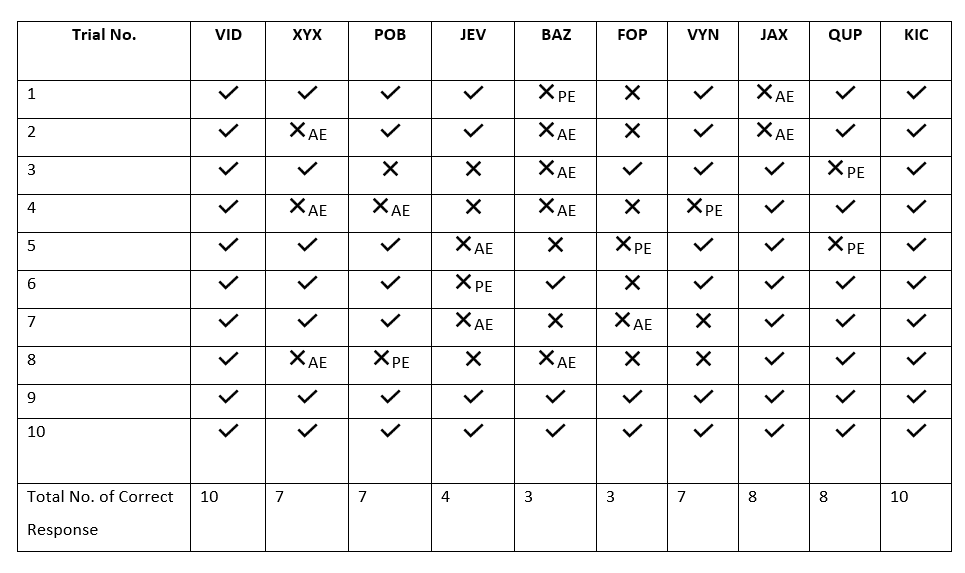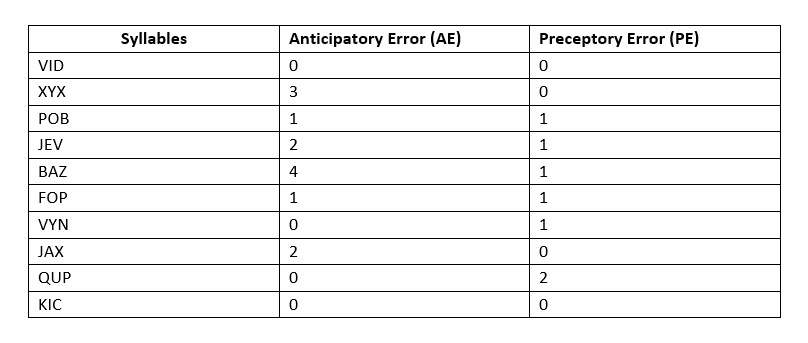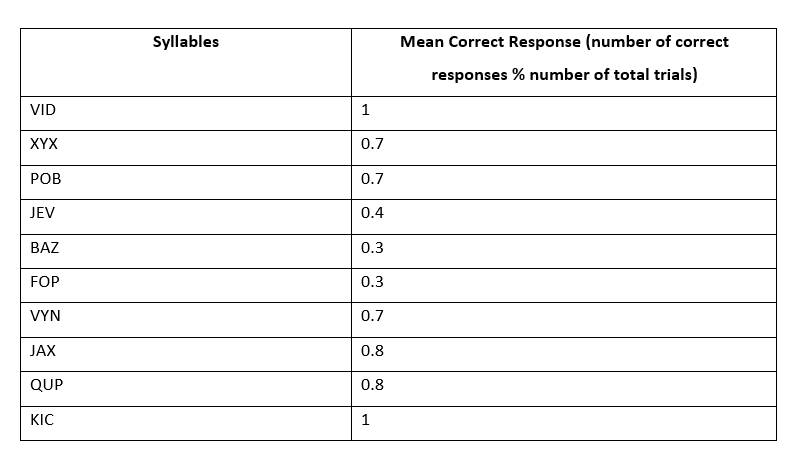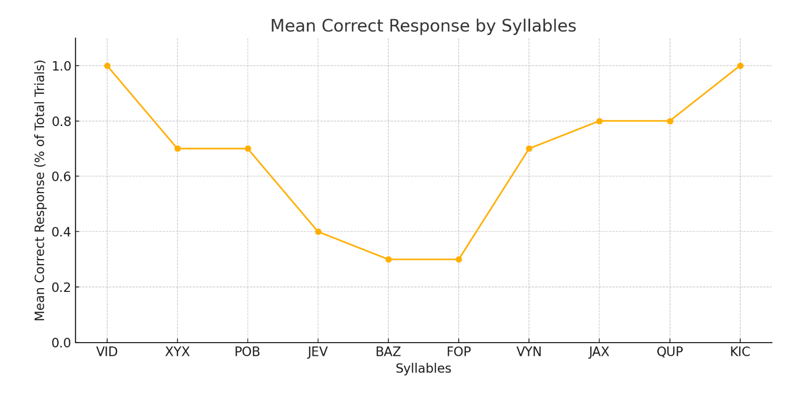Introduction to Serial Learning Experiment
Learning is a fundamental psychological process that forms the basis human behaviour, cognition, and development. Learning is defined as a relatively permanent change in behaviour resulting from experience, learning encompasses a broad spectrum of activities, from the acquisition of motor skills to the understanding of complex concepts. Whether it’s learning to ride a bicycle, understand a new language, or memorize historical facts, the process of learning is central to how humans adapt to their environment.
According to American psychological Association (APA) Learning is the acquisition of novel information, behaviors, or abilities after practice, observation, or other experiences, as evidenced by change in behavior, knowledge, or brain function. Learning involves consciously or nonconsciously attending to relevant aspects of incoming information, mentally organizing the information into a coherent cognitive representation, and integrating it with relevant existing knowledge activated from long-term memory.
Psychologists have long studied learning in various forms, focusing on how individuals acquire new knowledge, behaviours, or skills. Different learning mechanisms have been categorized based on their underlying processes, including classical conditioning, operant conditioning, and cognitive learning.
Definitions and Types of Learning
Learning occurs in different contexts through various mechanisms, each with its own defining characteristics. The primary types of learning include:
- Classical Conditioning– A type of learning where an individual learns to associate two stimuli. For example, a neutral stimulus (like a bell) becomes associated with a meaningful stimulus (like food), resulting in a conditioned response (like salivation) (Pavlov, 1927).
- Operant Conditioning– This form of learning is driven by the consequences of behaviour. Actions followed by rewards are more likely to be repeated, while those followed by punishment are less likely to recur. Operant conditioning emphasizes the role of reinforcement and punishment in shaping behaviour (Skinner, 1953).
- Cognitive Learning– Cognitive learning involves acquiring knowledge by processing information. It focuses on mental activities such as thinking, memory, problem-solving, and understanding. Unlike conditioning, cognitive learning is not dependent on direct experience with stimuli or reinforcement but instead involves internal processing (Tolman, 1932).
- Verbal Learning– A unique type of learning focused on words, ideas, and concepts, often involving structured sequences of verbal material. Verbal learning is commonly studied through experimental methods like paired-associates learning, serial learning, and free recall (Crowder, 1976).
Serial Learning
Serial learning is a specialized form of verbal learning in which an individual is required to learn and recall a list of verbal items, such as words, syllables, or numbers, in the exact sequence in which they were presented. This type of learning is essential for understanding cognitive processes related to memory and the order in which information is recalled (Ebbinghaus, 1885).
Ebbinghaus and the Study of Serial Learning
Hermann Ebbinghaus, a German psychologist, was a pioneer in the study of memory and learning, particularly in the realm of serial learning. His groundbreaking experiments, conducted in the late 19th century, provided a systematic and scientific approach to understanding how people acquire, store, and recall information. Ebbinghaus developed novel experimental techniques to study serial learning, using lists of nonsense syllables to examine memory without the interference of prior associations or meaning.
Ebbinghaus’ Experiment
Ebbinghaus conducted his most famous experiments on himself, using nonsense syllables (e.g., “zod,” “lef,” “tir”) to eliminate the influence of prior associations. His study of serial learning was groundbreaking because it allowed him to observe the cognitive processes involved in memory formation without interference from pre-existing knowledge. He meticulously measured how long it took to learn lists of these syllables and how quickly he forgot them over time.
His experimental procedure involved the following steps-
- List Construction- Ebbinghaus created lists of 13 nonsense syllables. He chose nonsense syllables deliberately to prevent semantic associations and avoid interference from previous knowledge (Ebbinghaus, 1885).
- Learning Phase- He read through the list of syllables repeatedly at a consistent pace until he could recall all the items in the correct order. Ebbinghaus then measured how many trials it took for him to achieve perfect recall. His results showed that repetition was a key factor in learning and memory retention.
- Testing for Recall- After a period of time, Ebbinghaus tested his ability to recall the syllables in the exact order. This helped him analyse how much information was retained and how much was forgotten over time. He documented that his ability to recall the items declined rapidly at first but then levelled off, leading to the formulation of the **forgetting curve**.
- Forgetting Curve- Ebbinghaus discovered that memory decayed at an exponential rate. Immediately after learning, a significant amount of information was forgotten, but the rate of forgetting decreased over time. This curve demonstrated that most forgetting occurs within the first few hours or days after learning, with the rate slowing down afterward (Ebbinghaus, 1885).
- Savings in Relearning- One of the most important findings from Ebbinghaus’ research was the concept of “savings.” Even after forgetting most of the syllables, he found that relearning the list took less time than the initial learning, suggesting that some trace of the memory remained.
The experimental design was revolutionary for its use of controlled stimuli (nonsense syllables) and the self-experimentation approach. The results from these experiments are still foundational in memory research today.
Serial Position Effect
The serial position effect is one of Ebbinghaus’ most significant contributions to the study of memory. It describes how individuals are more likely to remember items at the beginning (primacy effect) and the end (recency effect) of a list than those in the middle.
This finding suggests that items at the beginning of a list benefit from greater rehearsal and encoding into long-term memory, while items at the end are still fresh in short-term memory, making them easier to recall. Items in the middle of the list are typically forgotten because they lack both the primacy and recency advantages (Murdock, 1962).
This effect was also studied by Murdock, he found that strong evidence for the serial position effect. His study aimed to understand how the position of items in a list affects recall, and to examine the distinction between short-term and long-term memory processes.
Murdock conducted his study by presenting participants with lists of words that varied in length (ranging from 10 to 40 words). The words were presented at a fixed rate (usually one word per second). After the presentation of the list, participants were immediately asked to recall as many words as they could, in any order (free recall).
Murdock observed that participants showed a clear serial position effect, which was divided into two parts-
- Primacy Effect-Words presented at the beginning of the list were more likely to be recalled. This effect was attributed to the fact that participants had more time to rehearse and commit these words to long-term memory (LTM).
- Recency Effect– Words presented at the end of the list were also recalled more accurately. This was because the last items were still fresh in short-term memory (STM) at the time of recall.
Words in the middle of the list were recalled less frequently than those at the beginning and end, indicating that they were neither adequately rehearsed for LTM nor still present in STM.
In addition to the serial position effect, Ebbinghaus introduced the forgetting curve, which illustrates how information is lost over time if no effort is made to retain it. According to Ebbinghaus, the rate of forgetting is initially rapid but levels off over time. This curve highlights the importance of repetition and review in maintaining memory retention over the long term.
Verbal Learning
Verbal learning has been a central focus in the study of cognitive psychology, particularly because of its relevance to language acquisition, education, and everyday memory processes. Various methods have been developed to investigate how people learn and recall verbal material, each designed to uncover different aspects of memory and cognition.
Some of the common experimental methods used in verbal learning studies include paired-associates learning, serial learning, and free recall (Crowder, 1976).
Paired-Associates Learning
Paired-associates learning involves the presentation of pairs of words or syllables. The first item in the pair serves as the stimulus, and the second item is the response. The task for the participant is to recall the second item when prompted with the first. This method is often used in studies of language learning, such as learning vocabulary where the first word might be in the native language, and the second is in a foreign language. Paired-associates learning highlights the stimulus-response (S-R) relationship in memory.
2. Serial Learning
Serial learning, as previously defined, focuses on how people learn and recall lists of verbal items in a specific order. Ebbinghaus was one of the first to employ this method by using nonsense syllables in his experiments, allowing him to avoid interference from previous knowledge or associations. In a typical serial learning experiment, participants are presented with a list of words or syllables and are tasked with recalling them in the exact order they were presented. Initially, participants make many errors, but through repetition, they improve their recall and develop expectations for the next item in the list (Ebbinghaus, 1885).
Serial learning experiments provide insights into the structure of memory, revealing how order and sequence influence recall. This method is particularly relevant to understanding how people remember sequences, such as numbers in a phone number or steps in a process.
3. Free Recall
In contrast to serial learning, free recall allows participants to remember and list items from memory in any order they choose, rather than in the specific sequence in which they were presented. Free recall is often used to study how people organize information in their memory. One key finding from free recall experiments is category clustering, where participants group related items together during recall. For example, if a list contains items from several categories (e.g., animals, professions, fruits), participants tend to recall all the items from one category before moving on to another (Bousfield, 1953).
Determinants of Verbal Learning
Several factors influence verbal learning and memory, including the length of the list, the meaningfulness of the material, and the time spent on learning. These factors play a crucial role in determining how effectively verbal material is learned and recalled (Underwood, 1957).
- Length of the List- One of the most straightforward determinants of verbal learning is the length of the list to be learned. Generally, shorter lists are easier to learn and recall than longer lists. As the number of items in a list increases, so does the cognitive load, making it more difficult to encode, store, and retrieve all the items in the correct order. This effect has been well-documented in serial learning experiments, where participants tend to struggle more with longer lists.
- Meaningfulness of Material– Another critical factor is the meaningfulness of the material being learned. Meaningful material is easier to learn and remember than non-meaningful or random information. Psychologists have developed methods to measure meaningfulness by assessing the number of associations a word or concept elicits, its familiarity, and the relationships between items in a list. Lists composed of semantically related items (e.g., types of fruit) are generally learned more easily than lists of nonsense syllables or unrelated items (Paivio, 1965).
- Total Time Principle– The total time principle is another important determinant of verbal learning. This principle suggests that the total time spent learning is directly proportional to the amount of information retained. The more time devoted to learning a given list, the more effectively the material is encoded and stored in memory. This principle holds true across various types of learning, including both verbal and non-verbal tasks.
Serial Learning Experiment
Hypothesis of Serial Learning Experiment
The first items in the list will be learnt most rapidly, the last items in the list will be learnt less rapidly, and the middle items in the list will be learnt least rapidly.
Variables in Serial Learning Experiment
- Independent Variable– serial position of an item
- Dependent Variable– learning time per item
- Control Variable– difficulty level of the nonsense syllable
Materials in Serial Learning Experiment
- List of 10 Nonsense Syllables– A pre-prepared list of 10 syllables that are random and meaningless to avoid any semantic association or prior knowledge.
- Memory Drum– A device that presents the syllables in a consistent, timed manner (e.g., 2 seconds per syllable) to ensure uniform presentation across trials.
- Pre-arranged Record Sheet- Used to record learning time, correct responses, anticipatory errors (responses made too early), and preceptory errors (responses made too late or skipped).
- Stationery- Pencils and pens for recording the learning times and participant responses.
Plan of Serial Learning Experiment

Plan of Serial Learning Experiment
Procedure in Serial Learning Experiment
Each participant will be presented with a list of 10 nonsense syllables via the memory drum. The syllables will be shown one at a time, with a fixed interval (e.g., 2 seconds) between each presentation. After the entire list is presented, participants will be asked to recall the syllables in the exact order of presentation. Participants will attempt to recall the sequence of syllables after each trial. The experiment will continue until participants can correctly recall all 10 syllables in two consecutive trials.
If a participant recalls a syllable too early (before it is due to be recalled according to the serial order), it will be noted as an anticipatory error. If a participant recalls a syllable too late or skips it, it will be recorded as a preceptory error. The frequency and nature of both types of errors will be documented for each participant.
Precaution of Serial Learning Experiment
- Standardize Presentation Rate- Ensure that the presentation rate of the syllables or words is consistent for all participants to avoid introducing variations in learning time.
- Control for Fatigue- Schedule the experiment in short sessions or give breaks to participants to avoid fatigue, which could impact performance and recall.
- Use Neutral Nonsense Syllables- Ensure the nonsense syllables do not resemble familiar words to prevent bias or unintentional learning advantages.
- Minimize Environmental Distractions- Conduct the experiment in a quiet, controlled environment to reduce external distractions that could interfere with the participant’s concentration.
- Ensure Clear Instructions- Provide participants with clear, standardized instructions to ensure uniformity in understanding the task across all trials.
- Monitor Participant Engagement- Ensure that participants are actively engaged throughout the experiment to prevent a lack of effort or disinterest from affecting results.
- Control for Anticipation and Guessing- Ensure participants know not to guess if they are unsure of the next item to accurately record anticipatory or preceptory errors.
- Track Participant Condition- Make sure participants are in a good mental and physical condition before starting the experiment to avoid skewed results due to illness or fatigue.
Demo Result Table of Serial Learning Experiment

Result Table – Serial Learning Experiment

Erros in Serial Learning Experiment

Demo Mean Correct Response in Serial Learning Experiment
Interpretation of Serial Learning Experiment
The results show the mean correct response rates for each syllable, showcasing how the serial position effect influences memory recall. The first syllable, VID, demonstrates a perfect recall rate of 100%. This finding aligns with the primacy effect, which suggests that items presented at the beginning of a list are typically rehearsed more frequently and thus transferred to long-term memory more effectively. Similarly, the syllables XYX and POB, which appear early in the list, also exhibit relatively high recall rates (0.7), reinforcing the idea that early items benefit from greater encoding in memory.
In contrast, the last syllable, KIC, also shows a 100% correct response rate, illustrating the recency effect. This effect indicates that items presented at the end of the list are still fresh in short-term memory, making them easier to recall. Notably, JAX and QUP also demonstrate high recall rates of 0.8, further supporting the recency effect, as these items were presented near the end of the list and thus remain accessible in short-term memory.
Conversely, the syllables located in the middle of the list, specifically JEV, BAZ, and FOP, exhibit the lowest correct response rates (0.4, 0.3, and 0.3, respectively). This finding is characteristic of the serial position effect, which shows that items in the middle are harder to remember due to insufficient rehearsal and the lack of recent presentation. As a result, these middle items do not benefit from either the primacy or recency effects, leading to significantly poorer recall.

Graph of Serial Position Effect in Serial Learning Experiment
The results of this experiment clearly demonstrate the serial position effect, where items at the beginning and end of the list (like VID and KIC) are recalled more accurately than those presented in the middle (like JEV, BAZ, and FOP). These findings provide valuable insight into the cognitive processes underlying memory recall and the organization of information within our memory systems.
Conclusion
Serial learning experiments have provided invaluable insights into the nature of memory, particularly how people process and recall verbal information in a structured sequence. Hermann Ebbinghaus’ pioneering work, including his discovery of the serial position effect and the forgetting curve, laid the foundation for modern memory research. The experimental methods developed in the study of serial learning, paired-associates learning, and free recall continue to be widely used in cognitive psychology today. These methods reveal the importance of order, sequence, and meaning in how we learn and retain information.
The study of verbal learning, particularly through serial learning experiments, has practical applications in education, language acquisition, and even everyday memory tasks such as recalling shopping lists or phone numbers. Understanding the cognitive mechanisms that underlie serial learning can help in designing more effective teaching methods and memory aids, ultimately enhancing learning outcomes across various domains.
References for Serial Learning Experiment
Bousfield, W. A. (1953). The occurrence of clustering in the recall of randomly arranged associates. Journal of General Psychology, 49(2), 229-240.
Crowder, R. G. (1976). Principles of Learning and Memory. Erlbaum.
Ebbinghaus, H. (1885). Über das Gedächtnis: Untersuchungen zur experimentellen Psychologie. Duncker & Humblot. (Reprinted as Memory: A Contribution to Experimental Psychology, 1913).
Murdock, B. B. (1962). The serial position effect of free recall. Journal of Experimental Psychology, 64(5), 482-488.
Paivio, A. (1965). Abstractness, imagery, and meaningfulness in paired-associate learning. Journal of Verbal Learning and Verbal Behaviour, 4(1), 32-38.
Pavlov, I. P. (1927). Conditioned Reflexes: An Investigation of the Physiological Activity of the Cerebral Cortex. Oxford University Press.
Skinner, B. F. (1953). Science and Human Behaviour. Macmillan.
Tolman, E. C. (1932). Purposive Behaviour in Animals and Men. Century.
Underwood, B. J. (1957). Verbal Learning and Retention. Harper & Brothers.
Dr. Balaji Niwlikar. (2024, September 25). Serial Learning Experiment- Master Conduction & Report and Explore 2 Important Effects. Careershodh. https://www.careershodh.com/serial-learning-experiment/
